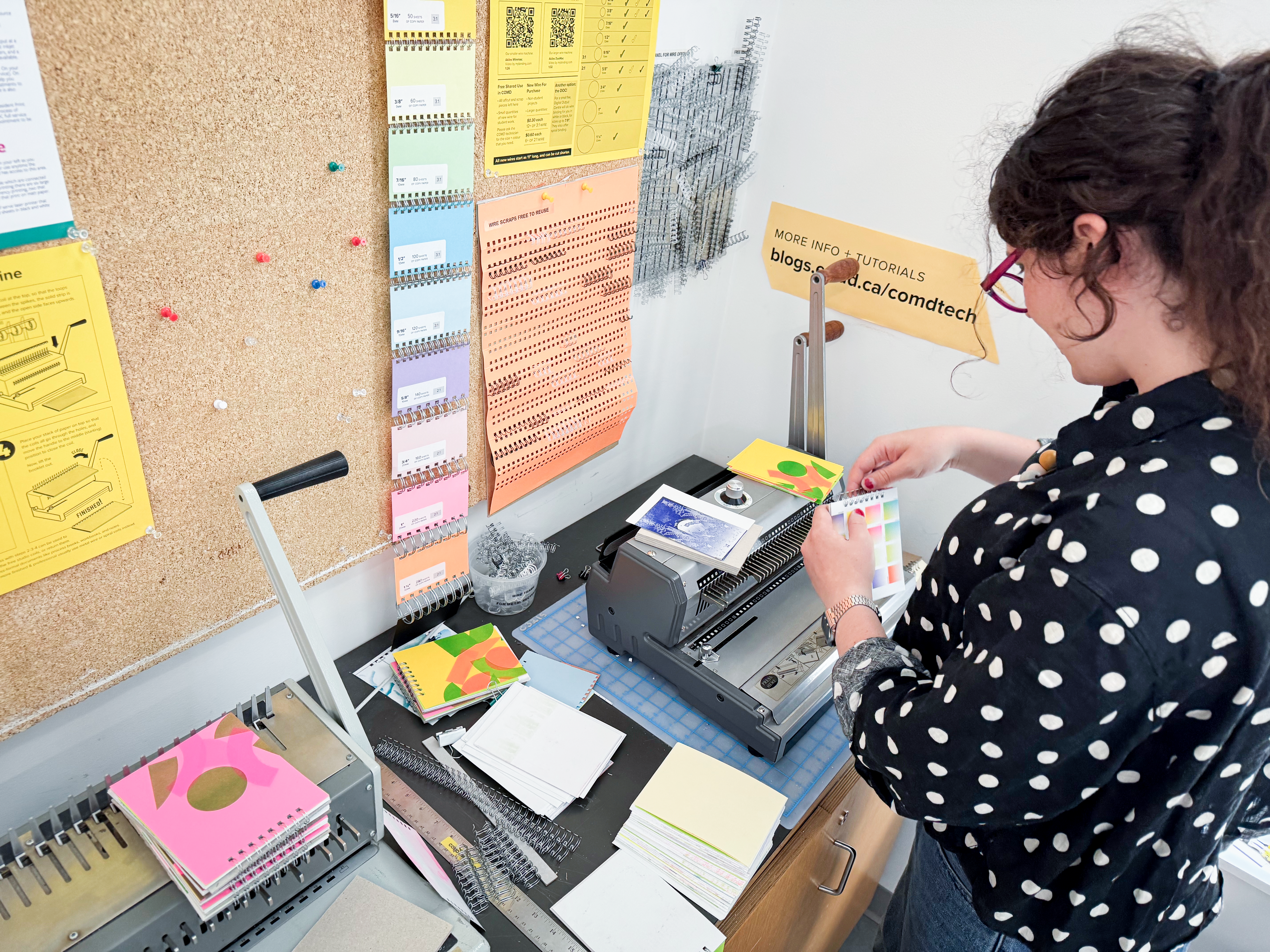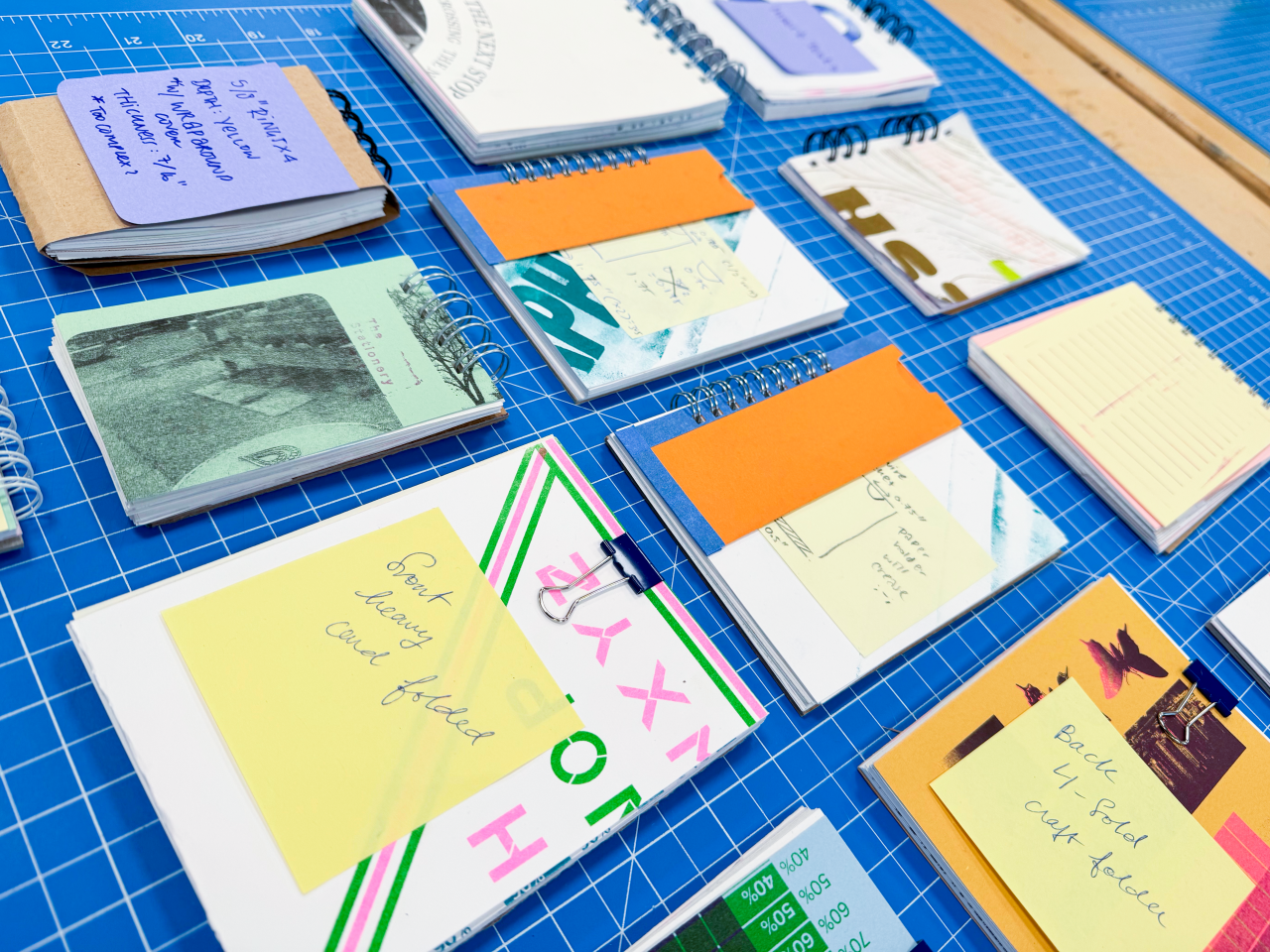The Stationery Project Creates New Suite of Sustainable Notebooks for Prospective Students

Faculty member and project participant Morgan Martino (MDes 2025) works in the Communication Design lab at ECU. (Photo courtesy The Stationery Project)
Posted on
Working with Student Services at ECU, a team of students, alums and faculty is developing custom stationery out of wastepaper salvaged from across the university.
A new partnership between Student Services and The Stationery Project at Emily Carr University of Art + Design (ECU) is creating a series of custom notebooks, pads and other writing materials from the leftover paper produced by labs, studios and galleries throughout the university.
Produced as gifts for prospective students, the custom materials embody university values, including circularity, sustainability and creativity, says designer and faculty member Katherine Gillieson.
“In places like our galleries, Digital Output Centre and especially the COMD Lab, which houses our Riso printers, ECU produces a lot of wastepaper, and it happens to be very beautiful,” says Katherine, who leads The Stationery Project. “The new, usable stationery we create from this paper embodies the spirit of Emily Carr University, and it reflects something about the actual student experience as well. It’s super customized and it’s extraordinary.”
The Stationery Project was established in 2017 by Julia Pepler (BDes 2018) and Katherine Gillieson as a circular-economy project with a zero-waste approach to creative bookbinding. Over the years, numerous faculty and students have participated in the project, which works to produce useful and creative stationery items for the community using as many recouped and waste materials as possible.

Produced as gifts for prospective students, The Stationery Project's recent suite of custom materials embody circularity, sustainability and creativity. (Photo courtesy The Stationery Project)
During one of The Stationery Project’s regular campus sales, the team was approached by Marcia Guno, ECU’s Vice Provost, Students. Marcia was impressed with their work and suggested creating a bespoke edition of notebooks for ECU recruitment events and other engagements with prospective students, as well as gifts for special guests on campus.
“Marcia and her team have been trusting and have a very progressive vision,” Katherine says. “She saw exactly what we’re trying to do — integrate into the fabric of the school and develop products for the community. This collaboration brings us deeper into the ecology of the school and helps to meet ECU’s needs through the use of its own internal resources. It also allows us to develop a workflow for a much larger volume, which we hadn’t done before.”
The custom stationery includes a variety of sizes and formats, derived from models that have been developed and tested over the years by The Stationery Project’s contributors. Each format is aimed at maximizing usability and minimizing leftover waste.
Alum and sessional faculty Morgan Martino (MDes 2025), a Stationery Project team member since 2018, recent graduate Kyla Zwack (BDes 2025) and student Abi Simatupang (BDes 2026) have all been vital contributors to the project, Katherine notes. In summer 2024, Morgan and Katherine ran the first-ever Stationery Project Creative Lab, a third-year Special Topics course. Kyla and Abi participated in the course, which focused on creative bookbinding practices using materials including textiles, cardstock and other materials salvaged from around campus.

The custom stationery includes a variety of sizes and formats, and are aimed at maximizing usability and minimizing leftover waste. (Photo courtesy The Stationery Project)
Katherine adds that The Stationery Project dovetails with the broader aims of ECU’s Communication Design program. Students learn practical skills for physical making, and are also introduced to research frameworks, design histories, considerations around use value and user needs, and technologies and tools such as the Risograph printer. The project also provides the context of a real-world project within which all these skills can be applied.
Meanwhile, the team is thrilled to share their work with a broader community.
“Our materials are generated from the work of ECU students, staff and faculty, and because the paper is recouped, you see little glimpses of past projects,” Katherine says. “Our stationery is also made by teams that include students, staff and faculty. So, it’s from the community and it reflects the community, as well as our values. We think it’s brilliant for Student Services to look internally and work with us for a project like this.”